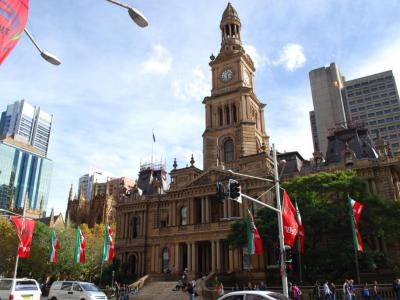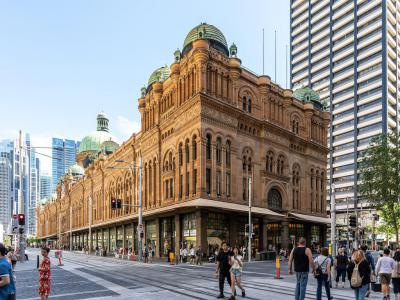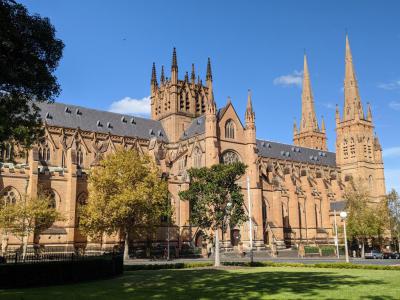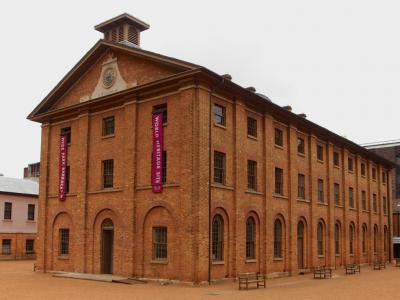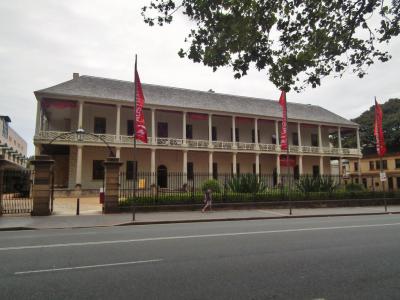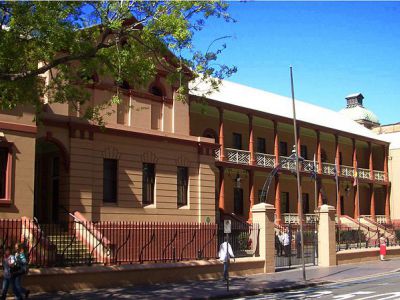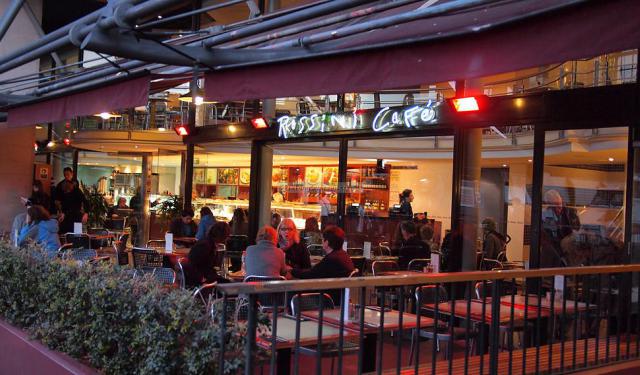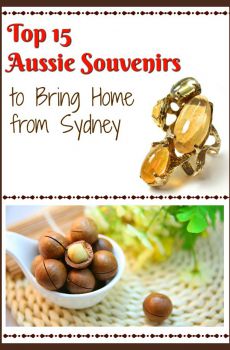
Sydney Introduction Walking Tour (Self Guided), Sydney
Sydney was found in 1788 when a fleet of eleven British ships arrived at where Sydney Cove is today. Onboard those pioneer vessels were 759 convicts plus sailors and marines to guard them. The city was named after Lord Sydney, the British Secretary of State who recommended the British government to establish a penal colony in Australia.
Human activity in the area that would later become Sydney goes back at least 30,000 years. The Aboriginal people, known as Eora, first encountered the British explorers around 1770. Between 1788 and 1792, the colony grew through the use of convict labor.
During the late 1700s and early 1800s, the British established farms, and the discovery of gold in 1851 drew more settlers into the region. After World War II, Sydney developed a diverse economy. Information technology, tourism, finance, and education are a few of the industries that have contributed to the city's modern prosperity.
The list of fascinating historical sights to see in Sydney is enormous. These include the Old Government House, the Macquarie Street buildings, the Sydney Mint, St. Mary's Cathedral, and the Sydney Town Hall. Among the cultural icons worth your time there are Sydney Opera House, Royal Botanic Gardens, and Hyde Park. Visitors will also enjoy views from Sydney Tower.
The Queen Victoria Building offers the types of upscale shopping that the most discerning consumers have come to expect. Stopping by the Darling Harbor area is an excellent way to enjoy more shopping, as well as dining and nightlife opportunities.
This self-guided walking tour takes you to explore some of Sydney's main attractions at your own pace and in your good time.
Human activity in the area that would later become Sydney goes back at least 30,000 years. The Aboriginal people, known as Eora, first encountered the British explorers around 1770. Between 1788 and 1792, the colony grew through the use of convict labor.
During the late 1700s and early 1800s, the British established farms, and the discovery of gold in 1851 drew more settlers into the region. After World War II, Sydney developed a diverse economy. Information technology, tourism, finance, and education are a few of the industries that have contributed to the city's modern prosperity.
The list of fascinating historical sights to see in Sydney is enormous. These include the Old Government House, the Macquarie Street buildings, the Sydney Mint, St. Mary's Cathedral, and the Sydney Town Hall. Among the cultural icons worth your time there are Sydney Opera House, Royal Botanic Gardens, and Hyde Park. Visitors will also enjoy views from Sydney Tower.
The Queen Victoria Building offers the types of upscale shopping that the most discerning consumers have come to expect. Stopping by the Darling Harbor area is an excellent way to enjoy more shopping, as well as dining and nightlife opportunities.
This self-guided walking tour takes you to explore some of Sydney's main attractions at your own pace and in your good time.
How it works: Download the app "GPSmyCity: Walks in 1K+ Cities" from Apple App Store or Google Play Store to your mobile phone or tablet. The app turns your mobile device into a personal tour guide and its built-in GPS navigation functions guide you from one tour stop to next. The app works offline, so no data plan is needed when traveling abroad.
Sydney Introduction Walking Tour Map
Guide Name: Sydney Introduction Walking Tour
Guide Location: Australia » Sydney (See other walking tours in Sydney)
Guide Type: Self-guided Walking Tour (Sightseeing)
# of Attractions: 13
Tour Duration: 2 Hour(s)
Travel Distance: 3.5 Km or 2.2 Miles
Author: nataly
Sight(s) Featured in This Guide:
Guide Location: Australia » Sydney (See other walking tours in Sydney)
Guide Type: Self-guided Walking Tour (Sightseeing)
# of Attractions: 13
Tour Duration: 2 Hour(s)
Travel Distance: 3.5 Km or 2.2 Miles
Author: nataly
Sight(s) Featured in This Guide:
- Darling Harbour
- Sydney Town Hall
- Queen Victoria Building (QVB)
- Sydney Tower
- Hyde Park
- Saint Mary's Cathedral
- Hyde Park Barracks
- Sydney Mint
- Parliament House
- Macquarie Street
- Royal Botanic Gardens
- Old Government House
- Sydney Opera House
1) Darling Harbour (must see)
The Darling Harbour is a recreational area of Sydney with many interesting tourist attractions. It is also the place where visitors take hop-on and off cruises around the harbour.
Named after Lieutenant General Ralph Darling, a former Governor General of New South Wales, it was once a thriving wharf and railway goods yard. Later, the location was declared unfit for its original purpose, and in the mid-1980s it was decided to make it into a recreation facility. It was opened in 1988 by Queen Elizabeth II as part of the city’s bicentennial celebrations. Darling Harbour runs from Chinatown, on both sides of Cockle Bay to Kings Street Wharf and Pyrmont.
Darling Harbour is administered by the Sydney Harbour Foreshore Authority. Major public attractions include the Chinese Gardens, Tombalong Park, Sydney Convention and Exhibition Center, Australian National Maritime Museum, an IMAX theater, and the Sydney Aquarium. Cockle Bay Wharf offers dining options for all tastes and price points. Events that take place here include the Darling Harbour Circus and Street Theatre, a Jazz Festival, the Darling Harbour Waiter’s Race, and the World’s Longest Buffet. It is one of the most popular attractions in Sydney and over a million people visit Darling Harbour every year.
Why You Should Visit:
A fun, buzzing, unique place that is fast becoming the heart of Sydney – when you see the food outlets and amazing shopping you'll understand why.
Morning, noon, or night, there's so much going on and you could sit here for hours taking it all in.
Tip:
Try heading down to the harbour between 4-7 pm, as pretty much every restaurant/bar will have a Happy Hour going with drink & food prices slashed down.
Take a ferry from Darling Harbour into Sydney – you get to see wonderful views of Sydney Harbour Bridge and the Sydney Opera House from the water!
Named after Lieutenant General Ralph Darling, a former Governor General of New South Wales, it was once a thriving wharf and railway goods yard. Later, the location was declared unfit for its original purpose, and in the mid-1980s it was decided to make it into a recreation facility. It was opened in 1988 by Queen Elizabeth II as part of the city’s bicentennial celebrations. Darling Harbour runs from Chinatown, on both sides of Cockle Bay to Kings Street Wharf and Pyrmont.
Darling Harbour is administered by the Sydney Harbour Foreshore Authority. Major public attractions include the Chinese Gardens, Tombalong Park, Sydney Convention and Exhibition Center, Australian National Maritime Museum, an IMAX theater, and the Sydney Aquarium. Cockle Bay Wharf offers dining options for all tastes and price points. Events that take place here include the Darling Harbour Circus and Street Theatre, a Jazz Festival, the Darling Harbour Waiter’s Race, and the World’s Longest Buffet. It is one of the most popular attractions in Sydney and over a million people visit Darling Harbour every year.
Why You Should Visit:
A fun, buzzing, unique place that is fast becoming the heart of Sydney – when you see the food outlets and amazing shopping you'll understand why.
Morning, noon, or night, there's so much going on and you could sit here for hours taking it all in.
Tip:
Try heading down to the harbour between 4-7 pm, as pretty much every restaurant/bar will have a Happy Hour going with drink & food prices slashed down.
Take a ferry from Darling Harbour into Sydney – you get to see wonderful views of Sydney Harbour Bridge and the Sydney Opera House from the water!
2) Sydney Town Hall
The ornate sandstone building on the site of a former cemetery, the Sydney Town Hall houses the offices of the Lord Mayor and city councillors. Before the inauguration of the Opera House, it was Sydney’s Concert Hall and many notable music performances took place here.
The Town Hall was built between 1868 and 1889. The foundation stone was laid by Prince Albert, the Duke of Edinburgh. Upon its completion, it was the grandest public building in the British Empire. The original structure was designed by architects Wilson, Bell & Bond. The architectural style is Grand Victorian Second Empire Italian Renaissance. The clock tower was built in 1881 and the clock was installed in 1885.
Following extensive repairs and refurbishment to suit modern requirements, the renovated Town Hall building was opened by Queen Elizabeth II in 1992.
The Centennial Hall at the centre of the building has the largest pipe organ in the world, which uses tubular pneumatic action. The interiors hold a wealth of carved figures, mosaic floors, and stained glass. A 20-minute tour takes visitors around the building explaining the history of the City. The surrounding square is also great in summer when the City Council puts out deck chairs for the public to use and relax in the sun or just eat lunch.
Tip:
Try to visit during one of the free organ recitals held every month, as nothing beats hearing the organ in operation.
The Town Hall was built between 1868 and 1889. The foundation stone was laid by Prince Albert, the Duke of Edinburgh. Upon its completion, it was the grandest public building in the British Empire. The original structure was designed by architects Wilson, Bell & Bond. The architectural style is Grand Victorian Second Empire Italian Renaissance. The clock tower was built in 1881 and the clock was installed in 1885.
Following extensive repairs and refurbishment to suit modern requirements, the renovated Town Hall building was opened by Queen Elizabeth II in 1992.
The Centennial Hall at the centre of the building has the largest pipe organ in the world, which uses tubular pneumatic action. The interiors hold a wealth of carved figures, mosaic floors, and stained glass. A 20-minute tour takes visitors around the building explaining the history of the City. The surrounding square is also great in summer when the City Council puts out deck chairs for the public to use and relax in the sun or just eat lunch.
Tip:
Try to visit during one of the free organ recitals held every month, as nothing beats hearing the organ in operation.
3) Queen Victoria Building (QVB) (must see)
The Queen Victoria Building is a large shopping mall in the heart of Sydney. The hundred-year-old structure has been recently restored and its ornate façade and interior displays carefully preserved.
The QVB was designed by architect George McRae. The architectural style is Romanesque Revival and it was built to provide employment to jobless skilled workers during a recession. The building was opened to the public in 1898 and named after the reigning British monarch, Queen Victoria. A statue of the queen greets visitors at the entrance. At the time of its inauguration, it contained cafes, showrooms, and a concert hall. Later it housed the central library and government offices. Between 1984 and 1986, the Malaysian firm, Ipoh Garden Berhad, leased the run-down and neglected Queen Victoria Building and restored it to its former splendour.
A notable architectural feature is the large central dome with glass on the inside and copper on the outside. There are four floors and stained glass windows allow light into the interiors, patterned floor tiles, and ornately wrought iron balustrades. Today, it has over 200 shops selling high-end products including fashion, jewelry, and traditional Australian crafts.
The renovations are very respectful to the era of the original build and everything about this building oozes sophistication. If not for the high-end boutiques, you can still enjoy a stroll through and marvel at the two beautiful clocks that still hang from the ceilings. It's also lovely to sit on the 2nd or 3rd levels at one of the cafés looking out at the unique clocks.
Tip:
Sydney was built over tunnels and underneath the QVB are two levels of tunnels for additional shopping.
At night the building is beautifully illuminated, the shops are closed and you can wander through and gaze at ease.
The QVB was designed by architect George McRae. The architectural style is Romanesque Revival and it was built to provide employment to jobless skilled workers during a recession. The building was opened to the public in 1898 and named after the reigning British monarch, Queen Victoria. A statue of the queen greets visitors at the entrance. At the time of its inauguration, it contained cafes, showrooms, and a concert hall. Later it housed the central library and government offices. Between 1984 and 1986, the Malaysian firm, Ipoh Garden Berhad, leased the run-down and neglected Queen Victoria Building and restored it to its former splendour.
A notable architectural feature is the large central dome with glass on the inside and copper on the outside. There are four floors and stained glass windows allow light into the interiors, patterned floor tiles, and ornately wrought iron balustrades. Today, it has over 200 shops selling high-end products including fashion, jewelry, and traditional Australian crafts.
The renovations are very respectful to the era of the original build and everything about this building oozes sophistication. If not for the high-end boutiques, you can still enjoy a stroll through and marvel at the two beautiful clocks that still hang from the ceilings. It's also lovely to sit on the 2nd or 3rd levels at one of the cafés looking out at the unique clocks.
Tip:
Sydney was built over tunnels and underneath the QVB are two levels of tunnels for additional shopping.
At night the building is beautifully illuminated, the shops are closed and you can wander through and gaze at ease.
4) Sydney Tower (must see)
Sydney Tower is a 300-meter tall structure that offers 360-degree views of the city. It is the second tallest tower in the Southern Hemisphere and is a member of the World Federation of Great Towers.
Construction of the Sydney Tower began as a shopping complex in 1970. The tower took ten years to build and was finally completed in September 1981. It is held in place by 56 cables weighing 7 tons each to resist strong gales and earthquakes. The tower is also stabilised by an enormous water tank at the top that holds 162,000 litres of water.
The Sydney tower stands on a 3-floor base that houses a shopping centre and restaurants. Three high-speed Double Decker elevators take visitors up to the top floors in less than 40 seconds. There are two restaurants and a coffee lounge at the top. From the enclosed observation deck, visitors can see sweeping views of Sydney Harbour, the Blue Mountains and the Opera House. There is also a skywalk that involves a walk on a glass-bottomed platform 268 meters above sea level. Skyguides show visitors Sydney landmarks through the glass floor. Two sets of steps serve as emergency exits and an annual Tour Run-Up race is held where participants climb 1304 out of 1504 steps. The event raises money for the Cancer Council.
Why You Should Visit:
To spend at least an hour admiring the view and browsing the gift shop.
Sydney is ridiculously pretty and it's nice to see where everything is in relation to everything else.
Tip:
Don't forget to book online for a cheaper price and also to avoid lines at the ticket counter.
Try coming during the day as you can see all the small islands nearby where they're impossible to be seen at night from the observation deck.
You may skip the Skywalk and go to 360 Bar and Dining, as it's usually less crowded, less expensive and the view is worth sitting down and watch for a while.
Construction of the Sydney Tower began as a shopping complex in 1970. The tower took ten years to build and was finally completed in September 1981. It is held in place by 56 cables weighing 7 tons each to resist strong gales and earthquakes. The tower is also stabilised by an enormous water tank at the top that holds 162,000 litres of water.
The Sydney tower stands on a 3-floor base that houses a shopping centre and restaurants. Three high-speed Double Decker elevators take visitors up to the top floors in less than 40 seconds. There are two restaurants and a coffee lounge at the top. From the enclosed observation deck, visitors can see sweeping views of Sydney Harbour, the Blue Mountains and the Opera House. There is also a skywalk that involves a walk on a glass-bottomed platform 268 meters above sea level. Skyguides show visitors Sydney landmarks through the glass floor. Two sets of steps serve as emergency exits and an annual Tour Run-Up race is held where participants climb 1304 out of 1504 steps. The event raises money for the Cancer Council.
Why You Should Visit:
To spend at least an hour admiring the view and browsing the gift shop.
Sydney is ridiculously pretty and it's nice to see where everything is in relation to everything else.
Tip:
Don't forget to book online for a cheaper price and also to avoid lines at the ticket counter.
Try coming during the day as you can see all the small islands nearby where they're impossible to be seen at night from the observation deck.
You may skip the Skywalk and go to 360 Bar and Dining, as it's usually less crowded, less expensive and the view is worth sitting down and watch for a while.
5) Hyde Park
Hyde Park is the oldest park in Australia. The on-site highlights include a collection of monuments and statues, a reflection pool, ANZAC Memorial, and a visitor center. The Nagoya and Sandringham Gardens showcase public art and water-related effects. The Archibald Fountain, one of Sydney's significant icons, is also within the park.
On top of that, there is a large collection of trees (over 500) including both exotic and native species. The central pedestrian walkway area has a line of Hill's fig trees. These trees line the area from the ANZAC Memorial to Macquarie Street. There are also plenty of places to relax and enjoy the sun, or maybe do some people-watching.
During the year, the park hosts several events such as ANZAC Day, Australia Day, the Food and Wine Fair, and the Sydney Festival. You never know what you might see going on here at any time.
On top of that, there is a large collection of trees (over 500) including both exotic and native species. The central pedestrian walkway area has a line of Hill's fig trees. These trees line the area from the ANZAC Memorial to Macquarie Street. There are also plenty of places to relax and enjoy the sun, or maybe do some people-watching.
During the year, the park hosts several events such as ANZAC Day, Australia Day, the Food and Wine Fair, and the Sydney Festival. You never know what you might see going on here at any time.
6) Saint Mary's Cathedral (must see)
The mother church of Australian Catholicism, St. Mary’s Cathedral, is the largest church in Australia. It is a functioning place of worship and an important landmark in Sydney.
The cathedral's foundation stone was laid in 1821 and the structure was completed in 1835, only to be destroyed by a fire in 1865. Father McEnroe, the then Archdeacon, commissioned the building of the present church designed by architect William Wardell in the Gothic Revivalist style. Although generally completed in 1882, work on the church continued after its dedication and improvements have been continually made to embellish the building. In 1930, the church was given the title of a minor basilica by Pope Pius XI and was the focus of World Youth Day in 2008, when it was visited by Pope Benedict XVI.
St. Mary’s Cathedral’s exterior is clad with dressed Pyrmont stone. It has twin towers facing south and a cruciform design with a central tower where the nave and transepts meet. The interiors have windows with picturesque stained glass, intricate sculpture, and a poignant monument to fallen soldiers.
The impressive flight of stairs leading up to the entrance and the two slender spires pointing to the sky make this elegant minor basilica amazing, chiefly when the walls glitter in gold light in the sunbeams.
Tip:
The best view of the сathedral is probably from College Street. Pick your visiting time carefully because of the regular services and the irregular but very frequent weddings. NOTE: during the weddings, you can't walk in to see the сathedral inside.
The cathedral's foundation stone was laid in 1821 and the structure was completed in 1835, only to be destroyed by a fire in 1865. Father McEnroe, the then Archdeacon, commissioned the building of the present church designed by architect William Wardell in the Gothic Revivalist style. Although generally completed in 1882, work on the church continued after its dedication and improvements have been continually made to embellish the building. In 1930, the church was given the title of a minor basilica by Pope Pius XI and was the focus of World Youth Day in 2008, when it was visited by Pope Benedict XVI.
St. Mary’s Cathedral’s exterior is clad with dressed Pyrmont stone. It has twin towers facing south and a cruciform design with a central tower where the nave and transepts meet. The interiors have windows with picturesque stained glass, intricate sculpture, and a poignant monument to fallen soldiers.
The impressive flight of stairs leading up to the entrance and the two slender spires pointing to the sky make this elegant minor basilica amazing, chiefly when the walls glitter in gold light in the sunbeams.
Tip:
The best view of the сathedral is probably from College Street. Pick your visiting time carefully because of the regular services and the irregular but very frequent weddings. NOTE: during the weddings, you can't walk in to see the сathedral inside.
7) Hyde Park Barracks
Nowadays a museum, the Hyde Park Barracks once housed the large convict population transported to Australia from Britain.
The barracks were designed by emancipated convict architect, Francis Greenway, and built by convict labour between 1817 and 1819 as the first permanent shelter for convicts. The latter roamed the streets and the crime was rampant as a result before that.
Located at the centre of a walled compound of 2.16 hectares, the building has three floors. Other buildings inside the walls included a cookhouse, a bakery, and quarters for soldiers.
Since its closure in 1848, the property had many uses. It served as a dormitory for emigrant women awaiting the arrival of their families, an asylum for destitute women, and was later converted to government offices and courts of law.
In 1981, the Hyde Park Barracks became a museum run by the Historic Houses Trust of New South Wales. The first floor recreates the arrival of the first fleet of convicts and the life and times of the early convicts, including a confinement box and leg irons. The second floor recreates the history of the building after it ceased housing convicts. The top floor recreates barrack rooms with hammocks showing the dwelling place and conditions of convicts at the time.
The incredible levels of detail and unique displays throughout, mixing modern technologies with the old atmosphere and stories, enable you to understand more about Sydney's past – either on your own or with the aid of an excellent audio guide that helps bring the stories to life. The staff at the gift shop and the reception area are very friendly and informative. Set on beautiful grounds, the area is also beautiful to stroll around.
Tip:
There is a cute little restaurant right outside the museum that serves great lunch and drinks – it's fun to eat in the courtyard with ivy climbing up the walls behind.
The bathrooms are also located outside and behind the main barracks building which requires you to return your audio guide on the way out and recover it when you return.
The barracks were designed by emancipated convict architect, Francis Greenway, and built by convict labour between 1817 and 1819 as the first permanent shelter for convicts. The latter roamed the streets and the crime was rampant as a result before that.
Located at the centre of a walled compound of 2.16 hectares, the building has three floors. Other buildings inside the walls included a cookhouse, a bakery, and quarters for soldiers.
Since its closure in 1848, the property had many uses. It served as a dormitory for emigrant women awaiting the arrival of their families, an asylum for destitute women, and was later converted to government offices and courts of law.
In 1981, the Hyde Park Barracks became a museum run by the Historic Houses Trust of New South Wales. The first floor recreates the arrival of the first fleet of convicts and the life and times of the early convicts, including a confinement box and leg irons. The second floor recreates the history of the building after it ceased housing convicts. The top floor recreates barrack rooms with hammocks showing the dwelling place and conditions of convicts at the time.
The incredible levels of detail and unique displays throughout, mixing modern technologies with the old atmosphere and stories, enable you to understand more about Sydney's past – either on your own or with the aid of an excellent audio guide that helps bring the stories to life. The staff at the gift shop and the reception area are very friendly and informative. Set on beautiful grounds, the area is also beautiful to stroll around.
Tip:
There is a cute little restaurant right outside the museum that serves great lunch and drinks – it's fun to eat in the courtyard with ivy climbing up the walls behind.
The bathrooms are also located outside and behind the main barracks building which requires you to return your audio guide on the way out and recover it when you return.
8) Sydney Mint
The Sydney Mint functioned as a "rum" hospital for convicts and the poor from 1816 to 1854. Between 1855 and 1926, the building served as a Royal Mint branch, minting 1,200 tons of gold into 150 million sovereigns. From 1926 to 1997, the building hosted government offices including courts and various departments (over 20 in total).
"Bullion Bar and Dining" is an on-site French Bistro. The local chef has Parisian training that gives their food an authentic feel. At the same time, Australian produce helps provide a localized feel to the dishes. As an extra treat, the restaurant also hosts a daily High Tea.
The Caroline Simpson Library & Research Collection gives visitors the most in-depth look at how the space inside the building has been utilized over the years. The site is open to self-guided tours, allowing you to explore everything at your leisure.
"Bullion Bar and Dining" is an on-site French Bistro. The local chef has Parisian training that gives their food an authentic feel. At the same time, Australian produce helps provide a localized feel to the dishes. As an extra treat, the restaurant also hosts a daily High Tea.
The Caroline Simpson Library & Research Collection gives visitors the most in-depth look at how the space inside the building has been utilized over the years. The site is open to self-guided tours, allowing you to explore everything at your leisure.
9) Parliament House
The Parliament House Sydney complex – home to New South Wales Parliament – is a World Heritage Site. The oldest part of it, a mix of Georgian and Neo-Gothic architecture, dates back to 1816. The front verandah colonnade makes the facade particularly impressive.
The Legislative Assembly building is where the lower house meets. A Speaker's chair and ceremonial mace on its table are some of the highlights. Seating areas for assembly members flank the Speakers' chair, and there is also a gallery where members of the press sit. The Legislative Council Chamber, for the upper house, contains a vice-regal chair made from red cedar. Seven busts of former Council members are also in this chamber, four of which are depicted wearing ceremonial dress and three – Roman-style togas.
One of the most accessible areas to the general public is the Fountain Court, an exhibition spot with a fountain. The small theatre here for 166 seats is quite snug. There is even a roof garden above the theaterette.
Free guided tours are available every day and the guides are very knowledgeable. You can learn a lot about the history of the building and Australia.
Tip:
If you're interested in seeing the NSW democracy at work, you should go on sitting days when the Parliament is in session. NOTE: while you can listen to the debates, you will see less because the visits on these days are restricted to the Visitors' Galleries only. On non-sitting days, both historic chambers can be visited.
The Legislative Assembly building is where the lower house meets. A Speaker's chair and ceremonial mace on its table are some of the highlights. Seating areas for assembly members flank the Speakers' chair, and there is also a gallery where members of the press sit. The Legislative Council Chamber, for the upper house, contains a vice-regal chair made from red cedar. Seven busts of former Council members are also in this chamber, four of which are depicted wearing ceremonial dress and three – Roman-style togas.
One of the most accessible areas to the general public is the Fountain Court, an exhibition spot with a fountain. The small theatre here for 166 seats is quite snug. There is even a roof garden above the theaterette.
Free guided tours are available every day and the guides are very knowledgeable. You can learn a lot about the history of the building and Australia.
Tip:
If you're interested in seeing the NSW democracy at work, you should go on sitting days when the Parliament is in session. NOTE: while you can listen to the debates, you will see less because the visits on these days are restricted to the Visitors' Galleries only. On non-sitting days, both historic chambers can be visited.
10) Macquarie Street
Macquarie Street is one of the most famous streets in Sydney's Central Business District. Some of the top landmarks here include Hyde Park and the Sydney Opera House, not to mention major public institutions of New South Wales.
Most buildings lining this street date to the 19th and early 20th centuries. St. James Church, completed in 1824, the Sydney Hospital built in 1894, and the Sydney Conservatorium of Music building from 1815 are among the most popular with visitors. Hengrove Hall, originally serving as barristers' chambers after its completion in 1928, has an impressive facade. Another building famous for its facade is the Chief Secretary building.
Among the 19th-century buildings of note are the Sydney Mint (1816), the former Treasury (1899), the Hyde Park Barracks (1819), and the History House (1872) presently owned by the Royal Australian Historical Society. As for the early 20th-century architecture, check out the 1930 British Medical Association building and the State Library completed in 1910.
Most buildings lining this street date to the 19th and early 20th centuries. St. James Church, completed in 1824, the Sydney Hospital built in 1894, and the Sydney Conservatorium of Music building from 1815 are among the most popular with visitors. Hengrove Hall, originally serving as barristers' chambers after its completion in 1928, has an impressive facade. Another building famous for its facade is the Chief Secretary building.
Among the 19th-century buildings of note are the Sydney Mint (1816), the former Treasury (1899), the Hyde Park Barracks (1819), and the History House (1872) presently owned by the Royal Australian Historical Society. As for the early 20th-century architecture, check out the 1930 British Medical Association building and the State Library completed in 1910.
11) Royal Botanic Gardens (must see)
The Royal Botanic Gardens, located to the East of the Sydney Opera House, overlooking Farm Cove, is the former farmland established by Governor Philips, the founder of Sydney.
Surrounding the gardens is the Domain, a green space adjacent to the Government House, founded by Governor Macquarie in 1916. The first Colonial Botanist, Charles Frazer, began the collection and study of plants in the garden thus making it the oldest scientific institution in Australia.
Each year, the gardens welcome over a million visitors coming to see the trees and plants (some of which are quite rare) from across Australia, plus the population of unique birds and fruit bats. There is a large pond with ducks, the white-faced heron, and other aquatic birds.
The Royal Botanic Gardens are divided into several themed sections such as the Palm Grove, the Oriental Garden, and the Herb Garden. Also interesting are the Rainforest Walk, the Succulent Garden with desert plants, and the Australian Native Rockery.
The place is family friendly and children and adults are free to walk and play on the grass and observe the plants at close quarters. The entry is free and visitors can enjoy picnics right there on the lawn.
This super cool location on the side of the Bay is the place you can hardly get bored of; a visit here easily can be a whole day's entertainment. You can use the train for an overview of the place; however, walking is just as entertaining a way to get around. If you plan to have longer hours in the Gardens, there are also restaurants, as well as a café, plus plenty of benches in the shade, where a tired visitor can have a rest.
Tip:
Don't forget to check out Mrs. Macquarie's Chair, from where the wife of Governor Macquarie was watching the ships sailing into the Harbour – a great vantage point with beautiful views!
Also, try and book the Aboriginal Heritage tour, which is about an hour long and runs on Wednesday, Friday, and Saturday mornings at 10 am.
Surrounding the gardens is the Domain, a green space adjacent to the Government House, founded by Governor Macquarie in 1916. The first Colonial Botanist, Charles Frazer, began the collection and study of plants in the garden thus making it the oldest scientific institution in Australia.
Each year, the gardens welcome over a million visitors coming to see the trees and plants (some of which are quite rare) from across Australia, plus the population of unique birds and fruit bats. There is a large pond with ducks, the white-faced heron, and other aquatic birds.
The Royal Botanic Gardens are divided into several themed sections such as the Palm Grove, the Oriental Garden, and the Herb Garden. Also interesting are the Rainforest Walk, the Succulent Garden with desert plants, and the Australian Native Rockery.
The place is family friendly and children and adults are free to walk and play on the grass and observe the plants at close quarters. The entry is free and visitors can enjoy picnics right there on the lawn.
This super cool location on the side of the Bay is the place you can hardly get bored of; a visit here easily can be a whole day's entertainment. You can use the train for an overview of the place; however, walking is just as entertaining a way to get around. If you plan to have longer hours in the Gardens, there are also restaurants, as well as a café, plus plenty of benches in the shade, where a tired visitor can have a rest.
Tip:
Don't forget to check out Mrs. Macquarie's Chair, from where the wife of Governor Macquarie was watching the ships sailing into the Harbour – a great vantage point with beautiful views!
Also, try and book the Aboriginal Heritage tour, which is about an hour long and runs on Wednesday, Friday, and Saturday mornings at 10 am.
12) Old Government House
Surrounded by 260 acres of parkland, the Old Government House commands sweeping views of the Parramatta River and is an undisturbed natural reserve amid Australia’s biggest metropolitan area.
The house itself was built in 1799 and is Australia’s oldest public building. For seventy years, it served as the governor’s rural residence. The colony's first 10 governors resided here.
Governor Macquarie and his wife, who lived here from 1810 to 1821, are responsible for the majority of extensions and renovations made to the property, turning the originally small and rather simple structure into a Palladian-style English mansion.
Recently restored, the building's interior features typical Anglo- and Indian-style furnishing, sandstone flags, and a large hand-cut glass chandelier once common in fashionable houses during the 1820s.
The property occupies Darug land that was home to the Burramatta Tribe. Some of the trees surrounding the house still bear scars of the bark stripped to make canoes by the Aborigines. The Historic Houses Trust of New South Wales managing the Old Government House operates tours including a “haunted house” tour of the property.
The house itself was built in 1799 and is Australia’s oldest public building. For seventy years, it served as the governor’s rural residence. The colony's first 10 governors resided here.
Governor Macquarie and his wife, who lived here from 1810 to 1821, are responsible for the majority of extensions and renovations made to the property, turning the originally small and rather simple structure into a Palladian-style English mansion.
Recently restored, the building's interior features typical Anglo- and Indian-style furnishing, sandstone flags, and a large hand-cut glass chandelier once common in fashionable houses during the 1820s.
The property occupies Darug land that was home to the Burramatta Tribe. Some of the trees surrounding the house still bear scars of the bark stripped to make canoes by the Aborigines. The Historic Houses Trust of New South Wales managing the Old Government House operates tours including a “haunted house” tour of the property.
13) Sydney Opera House (must see)
The Sydney Opera House is a major Australian landmark and the most recognizable icon of Sydney – one of the greatest architectural works of the 20th century. Occupying a prominent place at Sydney Harbor, the building's creative use of a group of white interlocking shells as its roof makes it one of the most photographed buildings in the world.
There are several types of tours that visitors can take to learn more about the history behind this iconic structure. Visitors can also tour the backstage area or take a tour that has special activities for kids.
This opera house hosts six venues, offering different experiences depending on your interest. The Concert Hall, seating 2,000, hosts the Sydney Symphony Orchestra and the Australian Chamber Orchestra. For opera and ballet, the Joan Sutherland Theatre, with 1,500 seats, is the place.
Several dining options combined with excellent harbor views are also available, should you decide to grab something to eat or drink. The Opera Bar and Portside offer indoor and outdoor dining featuring Australian favorites, while Bennelong has a more formal setting with modern cuisine. If quick bites are more up your alley, try the Theatre Bars or The Lounge.
Tips:
Try a Foodie Tour that includes dining as a part of the experience.
There are several types of tours that visitors can take to learn more about the history behind this iconic structure. Visitors can also tour the backstage area or take a tour that has special activities for kids.
This opera house hosts six venues, offering different experiences depending on your interest. The Concert Hall, seating 2,000, hosts the Sydney Symphony Orchestra and the Australian Chamber Orchestra. For opera and ballet, the Joan Sutherland Theatre, with 1,500 seats, is the place.
Several dining options combined with excellent harbor views are also available, should you decide to grab something to eat or drink. The Opera Bar and Portside offer indoor and outdoor dining featuring Australian favorites, while Bennelong has a more formal setting with modern cuisine. If quick bites are more up your alley, try the Theatre Bars or The Lounge.
Tips:
Try a Foodie Tour that includes dining as a part of the experience.
Walking Tours in Sydney, Australia
Create Your Own Walk in Sydney
Creating your own self-guided walk in Sydney is easy and fun. Choose the city attractions that you want to see and a walk route map will be created just for you. You can even set your hotel as the start point of the walk.
Sydney's Historical Churches
Over the years, Sydney's historical churches have aroused a sense of admiration in many beholders. Some of these buildings have even become iconic symbols of Sydney, well worth going a good way to see as vivid examples of both historical and architectural value.
The impressive Early English-style of architecture seen in Saint Mary's Cathedral is said to have inspired the American... view more
Tour Duration: 1 Hour(s)
Travel Distance: 3.2 Km or 2 Miles
The impressive Early English-style of architecture seen in Saint Mary's Cathedral is said to have inspired the American... view more
Tour Duration: 1 Hour(s)
Travel Distance: 3.2 Km or 2 Miles
Historic Buildings Walking Tour
One of the Australia’s largest cities, Sydney is also the country's oldest metropolis. It has no shortage of impressive historical buildings, some dating back as far as the early 19th century. Many of the local landmarks, such as Sydney Town Hall, Queen Victoria Building (QVB), Hyde Park Barracks and others, are wonders in their own right and fit to delight any history buff.
One can... view more
Tour Duration: 2 Hour(s)
Travel Distance: 3.1 Km or 1.9 Miles
One can... view more
Tour Duration: 2 Hour(s)
Travel Distance: 3.1 Km or 1.9 Miles
Food Tour in Sydney
Sydney is a melting pot, and the local food culture is a sure testament to that. The inflow of immigrants from Europe and Asia over the years has turned the city into a much coveted foodie destination. This tour offers an introduction to the multifaceted and diverse food & brewery experience to be had here.
Start with Gateway Sydney, an upscale food court with WiFi and just about any kind... view more
Tour Duration: 1 Hour(s)
Travel Distance: 2.2 Km or 1.4 Miles
Start with Gateway Sydney, an upscale food court with WiFi and just about any kind... view more
Tour Duration: 1 Hour(s)
Travel Distance: 2.2 Km or 1.4 Miles
The Rocks Walking Tour
The Rocks is a historic area and the oldest neighborhood in downtown Sydney. It was the site where on 26 January 1788 a Union flag was raised to announce the establishment of the first British penal colony in New South Wales. Many of the old stone buildings are made of quarry stones hand-chipped by early convicts, which gave the area its name.
Today's Rocks is a thriving locality packed... view more
Tour Duration: 1 Hour(s)
Travel Distance: 1.3 Km or 0.8 Miles
Today's Rocks is a thriving locality packed... view more
Tour Duration: 1 Hour(s)
Travel Distance: 1.3 Km or 0.8 Miles
Newtown Street Murals Walking Tour
Whenever you think of street art in Sydney, one suburb immediately springs to mind and that is Newtown. Largely regarded as Sydney’s coolest neighborhood, this is a ground zero of the city's mural art scene.
Ever since the early 1990s, with the appearance of the famous “I Have a Dream” Mural on King Street, a powerful depiction of Martin Luther King Junior's iconic speech, this... view more
Tour Duration: 1 Hour(s)
Travel Distance: 1.3 Km or 0.8 Miles
Ever since the early 1990s, with the appearance of the famous “I Have a Dream” Mural on King Street, a powerful depiction of Martin Luther King Junior's iconic speech, this... view more
Tour Duration: 1 Hour(s)
Travel Distance: 1.3 Km or 0.8 Miles
Useful Travel Guides for Planning Your Trip
Top 15 Aussie Souvenirs to Bring Home from Sydney
"You haven't been anywhere if you haven't been to Australia," they say, and you'd definitely want something tangible in hand to remind you of the g'days spent Down Under. In Sydney, you will find tonnes of distinctly Oz products that would serve this purpose...
The Most Popular Cities
/ view all

